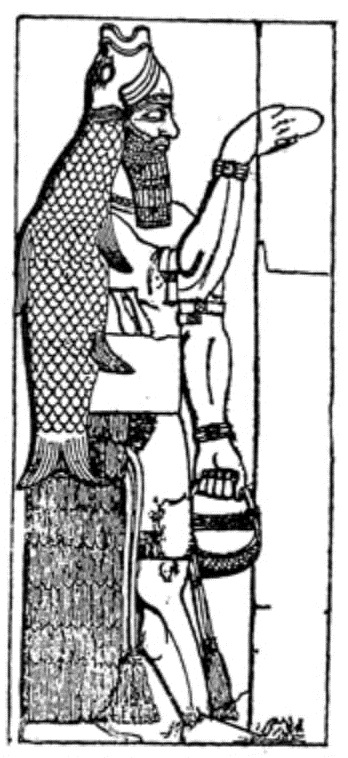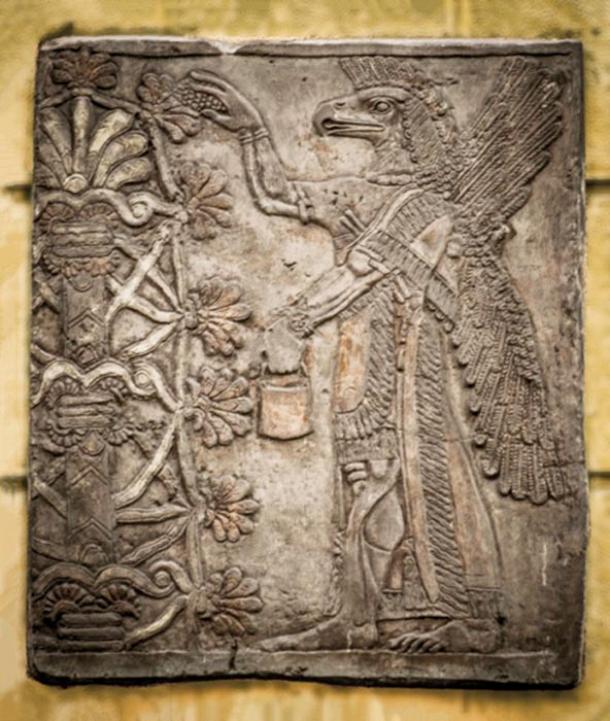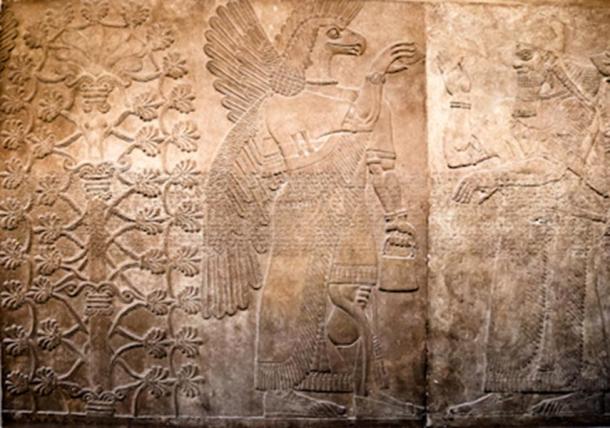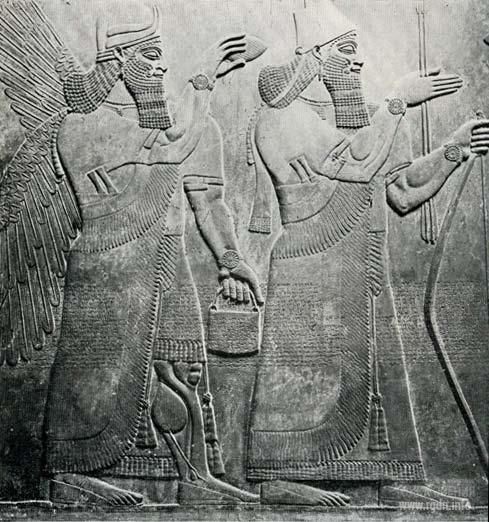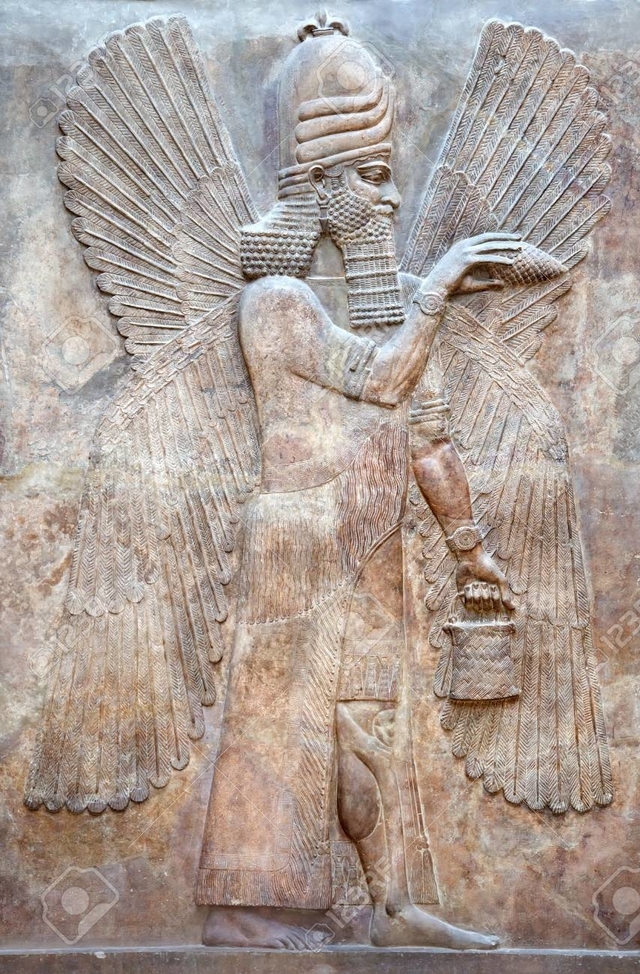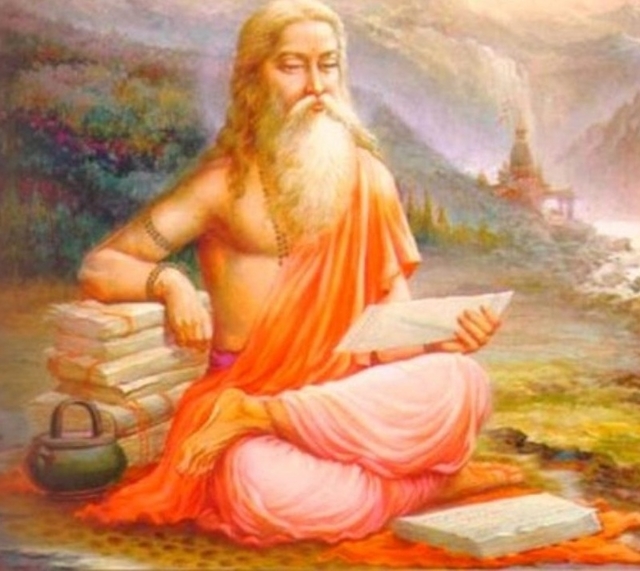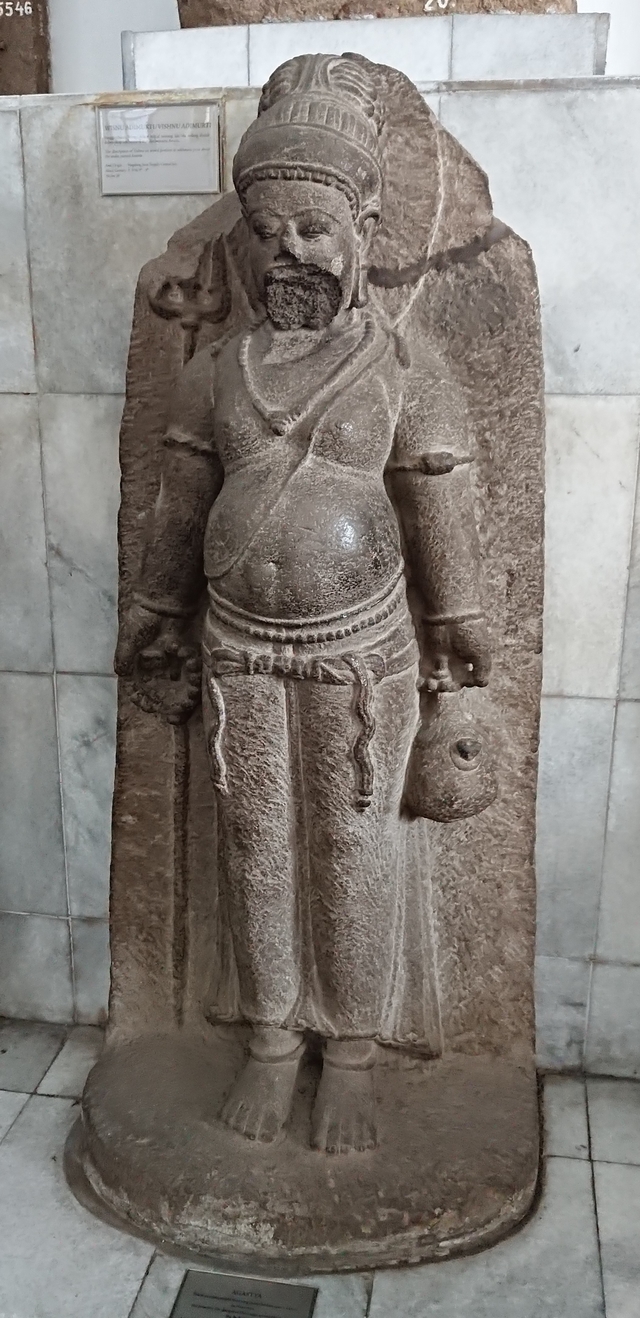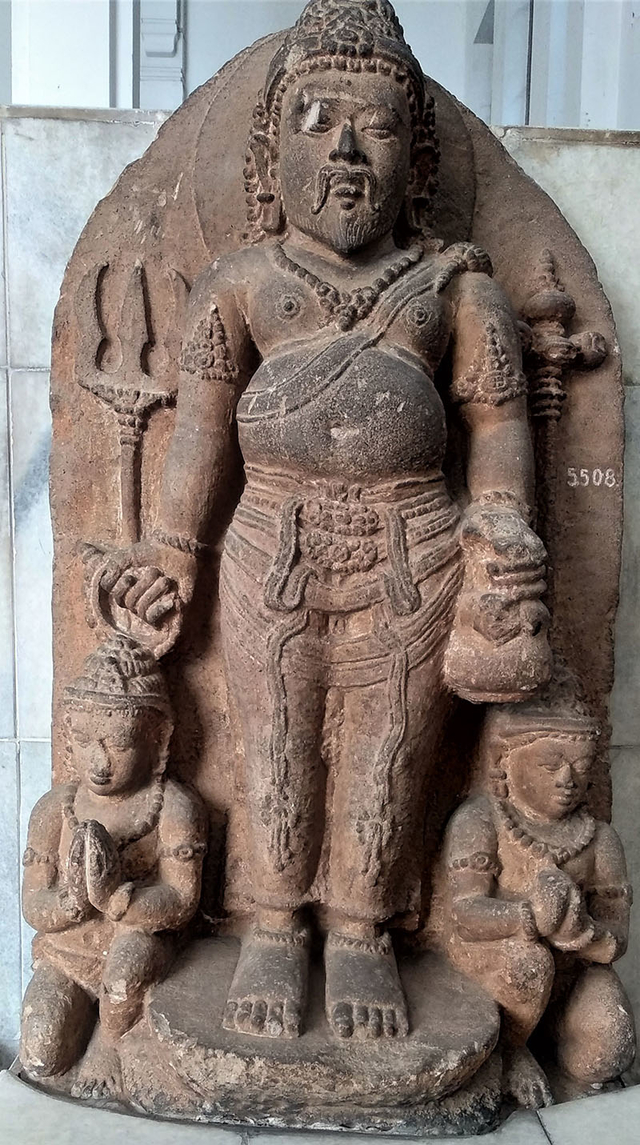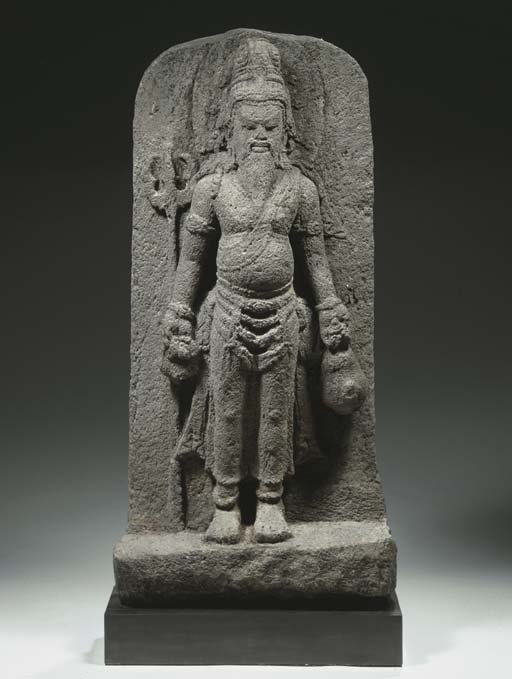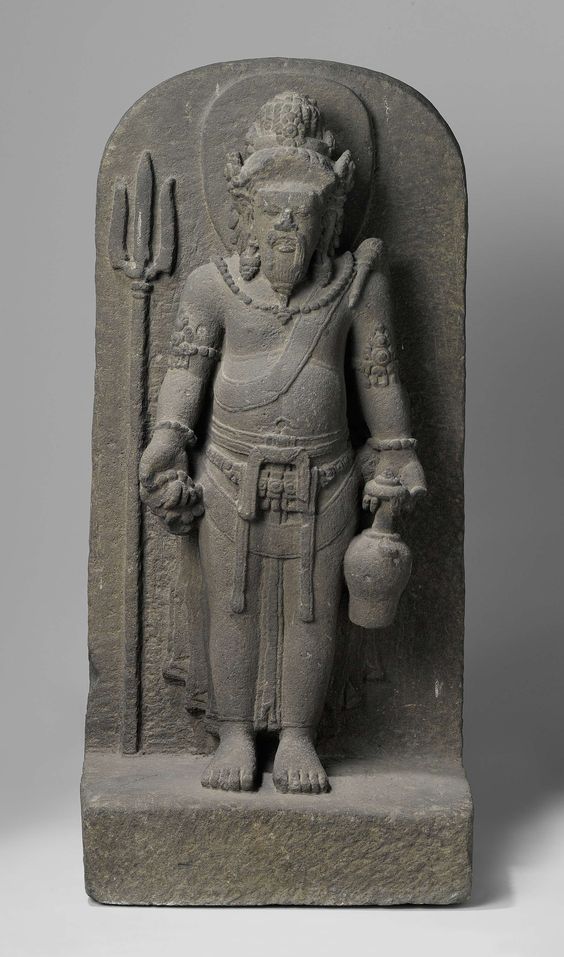
| BANDUDU / KAMANDAL 19. Bandudu / Kamandal :
The Fish-man divinity carrying a basket (Bandudu) and bestowing the Life-giving ambrosia of Resurrectionon on his name as the so-called "goddess Nina".
The Basket which Fish-man is carrying is known in India as Kamandal. In whichever country you find this sign of Kamandal it proves the presence of early Sumerian Aryan civilization.
This sort of statues are found to be in Sumerian Aryan civilization. In India and many other countries Aryan Brahmins of Sumerian civilization used to carry this sort of Basket known as Kamandal. Now a days we can find Non-Aryan Monks in India using Kamandal because they want to copy ancient Aryan Brahmins.
Bandudu and similarity between Sapt Rishis i.e. 7 Sages described in Vedic Aryans and Sumerian Aryans :
One of the great riddles in Mesopotamian sacred art concerns the image of anthropomorphic winged figures called Apkallu holding a mullilu (tree fruit) in one hand, and a banduddû — a container — in the other. It appears throughout Sumer and Babylon, and half a world away in Yucatan; six thousand years earlier, it was carved in relief upon Pillar 43 at Gobekli Tepe, one of the world's oldest standing stone enclosures. But what exactly was the purpose of this container? A look at cross-cultural symbolism in the images provides an answer.
The Apkallu are a group of seven sages, emissaries and mediating figures entrusted by a creator god to bring the civilizing arts to humanity following a catastrophic flood (Sapt Rishis i.e. 7 Sages). Their story is repeated almost verbatim in diluvial myths of many ancient cultures, the only changeable aspect being their names. The quintessential image of the Apkallu is that of two eagle, or perhaps falcon-headed people standing either side of a flowering tree, picking its fruit, and the manner in which they hold the container suggests the fruit are to be placed in said receptacle. Sometimes the figure of the supreme deity Ahura Mazda is depicted inside a winged disc above the axis of the tree, implying it is close to God, and thus, wisdom. This culturally shared image is known as the World Tree or Tree of Knowledge, and served as both focal point and foundation of all Mysteries teachings and traditions.
According to Lieutenant Colonel Laurence Austine Waddell :
The Indo-Sumerian Seals Deciphered (1925) :
Fig. 22 : Sun-Fish-man (S'ukha or Blesh) bestowing the ambrosia of Resurrection and Life, in Assyrio-Babylonian monuments (After Layard) This now recovers unknown name of the common Assyrio-Babylonian images of the Fish-man divinity traversing the waters (Fig. 21), or carrying a basket and bestowing the Life-giving ambrosia of Resurrection (Fig. 22). On his name as the so-called "goddess Nina".
This Sun-Fish divinity of the Resurrection and the Life of the old Aryan gentiles (non jewish) seems also the source of the title "The Fish" applied to Christ by the early Christian fathers and his symbol as such is usually represented facing eastwards like the Sumerian and Hittite Sun-Fish-god.
"S'ukha" name for the Resurrecting Sun-Fish is apparently the Sumerian source of the Sanskrit name Sukha for "heaven" and for "the western paradise of the God of the Deep" (Varun) who is represented in Indian mythology as a Fish-man as in the Sumerian seals of this Sun-Fish, or as riding upon a Fish. This Resurrecting Sun-Fish name "S'ukha" seems also to disclose the Sumerian origin of word on Amulet "Sukha" as "Swaha" in Sanskrit used by Brahmin for invocation and in Buddhist Amulet.
Sumerian Basket :
Wall relief depicting an eagle-headed and winged man
Detail of a relief from the palace of Assyrian king Sargon II, 722 - 705 BC. Found in the collection of Musée du Louvre, Paris. Artist : Assyrian Art
Ivory Panel Syro-Phoenician Nimrud 8th to 7th centuries BCE
Pergamon Museum in Berlin
God Ea (Sumerian Enki) with a fish-cloaked apkallu, part of a basalt water basin from Assur, Iraq, reign of Sennacherib, 7th century BCE. Pergamon Museum, Berlin, Germany
Assyrian king Ashurnasirpal II (r. ca. 883 - 859 B.C.) This relief, from the palace of the Assyrian king Ashurnasirpal II (r. ca. 883-859 B.C.), depicts a supernatural protective figure and a mortal Assyrian courtier. The two larger-than-life-sized figures are carved in low relief. This panel joins a second relief (32.143.4, see ‘Additional Images’ above) that shows the king and a second courtier. Together, the two panels show the king flanked by his human courtiers. The winged figure here formed part of a similar neighboring scene, this time with the king flanked by divine protectors.
The winged human-headed figure wears a horned crown - a traditional Mesopotamian marker of divine status - and bracelets adorned with rosettes, as well as armbands, a necklace of beads, and large pendant earrings. He wears a tunic with long tassels and a fringed shawl, emerging from which at chest level can be seen the decorated handles of two knives. Embroidery on the clothes is represented by fine incised patterns of stylized plant imagery at the ends of the sleeves and near the fringe of the shawl. The exposed lower leg with exaggerated musculature is seen in many Assyrian and Babylonian depictions of divine and heroic figures. The figure holds a small bucket in his left hand, and in his right an object resembling a pine-cone. This cone, called by the Assyrians a "purifier," seems to have been used to sprinkle holy water from the bucket, and may have had a symbolic association with the artificial fertilization of date-palm trees. The bucket itself is incised with the image two miniature winged figures performing the same act, not toward the king but toward a central 'sacred tree' and the winged disk associated with Assyria's chief god Ashur.
The second figure on the relief is human, and his beardless image indicates that he is probably a eunuch. He is richly dressed, with jewelry including rosette bracelets, armbands, a collar of beads, probably of semiprecious stone with gold spacers, pendant earrings, and a crescent-shaped pectoral. He carries multiple weapons: a bow, a quiver filled with arrows, a mace with a rosette-head, and a sword whose scabbard ends in the bodies of two lions. With the possible exception of the sword, these weapons are not his own but belong to the king. The courtier is shown as an arms-bearer, and in this sense the king's servant, but the position was one of symbolic authority, signifying closeness to the king, and in reality the figure depicted was probably one of the most senior figures in Ashurnasirpal's court.
A distinctive feature of the Northwest Palace is the so-called Standard Inscription that ran across the middle of every relief, often cutting across the imagery. The inscription, carved in cuneiform script and written in the Assyrian dialect of the Akkadian language, lists the achievements of Ashurnasirpal II (r. 883–859 B.C.), the builder of the palace. After giving his ancestry and royal titles, the Standard Inscription describes Ashurnasirpal’s successful military campaigns to east and west and his building works at Nimrud, most importantly the construction of the palace itself. The inscription is thought to have had a magical function, contributing to the divine protection of the king and the palace.
Anunnaki figure holding the handbag and pinecone, 883 – 859 B.C. Neo-Assyrian period, Nimrud (ancient Kalhu), Iraq
Sumerian Rock Relief
Sent by the creator god Ea, Apkallu function as cleansers, protectors, lawgivers and advisors. Here one administers to the Tree of Knowledge The iconic container appears throughout many carved panels and clay tablets found in the palace of Nimrud and its surrounding region. To solve the riddle, it is important to see the images together, because, placed in context, they appear to form a kind of triptych conveying a running commentary. Such a series of panels, removed from one of the rooms at Nimrud, is housed in the British Museum.
One panel shows two Apkallu administering to the sacred tree; in the next, an Apkallu has turned from the tree and bestows a king with the tree fruit, all the while holding that mysterious container. Clearly the king is conferred some special privilege.
The featured king is identified as Ashunarsipal, who was also a priest, a high initiate of the temple, and thus privy to secret knowledge that only such a position could allow. We know he held this position because in a separate frieze he is depicted holding a beehive above his head, a clear indication he has been initiated into the secrets of the beehive. We shall return to this thought later because it is central to understanding the purpose of the container.
Sumerian Stone Carving
Ancient Sumerian Stone Carving with Cuneiform Scripting Indian Kamandal :
Indian Aryan Brahmin Kamandal
Agastya statue in Indonesia Catalog
:
Material : Andesite
No Inventory : 64
No. Kepmendikbud :
Status : National-Scale Cultural Property
Characters :
Origin : Kedu
Placement : Rotunda
Description
:
Lord Shiv Statue, Indonesia Catalog
:
Material : Andesite
No Inventory : 5508
No. Kepmendikbud :
Status : National-Scale Cultural Property
Character : Agatsya
Origin : Candirejo, Magelang Regency (Distr. Grabag, afd. Magelang, Residency of Kedu, Ned. Indie)
Placement : Rotunda
Description :
Other Kamandal Statue Images :
Kamandal
Kamandal |
